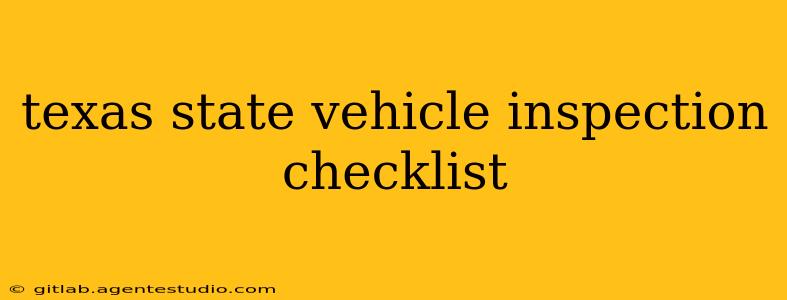Getting your vehicle inspected in Texas can feel daunting, but understanding the process beforehand can significantly reduce stress. This comprehensive guide details everything you need to know about the Texas state vehicle inspection checklist, ensuring a smooth and successful inspection. We'll cover what inspectors look for, how to prepare your vehicle, and what to do if your vehicle fails inspection.
What the Texas Vehicle Inspection Covers
The Texas Department of Public Safety (DPS) mandates specific checks during a vehicle inspection. The inspector will evaluate various aspects of your vehicle's safety and emissions. While the exact checklist can vary slightly between inspection stations, these are the key areas covered:
Brakes:
- Brake Pedal: The inspector will check for proper operation and responsiveness.
- Brake Lines and Hoses: Leaks, damage, and proper connections are verified.
- Parking Brake: Ensures it effectively holds the vehicle on an incline.
- Brake Lights: Functional brake lights are essential for safety.
Steering:
- Steering System: The inspector will check for proper play (free movement) and overall condition.
- Steering Linkage: Components are examined for wear, damage, and proper alignment.
Exhaust System:
- Leaks: The inspector will check for exhaust leaks that could be hazardous.
- Muffler: The muffler's condition and proper attachment are assessed.
- Emissions: (Depending on vehicle age and location) emission testing may be required.
Lights and Signals:
- Headlights: High and low beams must function correctly.
- Taillights: Ensuring they illuminate as they should.
- Turn Signals: Front and rear signals must operate properly.
- Brake Lights: As mentioned above, these are critical for safety.
- Reverse Lights: Must work correctly to signal the vehicle is reversing.
Tires:
- Tread Depth: Tires must meet minimum tread depth requirements.
- Condition: Inspectors look for any significant damage, bulges, or uneven wear.
- Inflation: Proper tire pressure is essential.
Windshield:
- Wipers: Wipers must clear the windshield effectively.
- Cracks and Chips: Significant cracks or chips that obstruct vision are unacceptable.
Mirrors:
- Condition: Mirrors must be intact and securely attached.
Seatbelts:
- Functionality: All seatbelts must function correctly and be securely fastened.
Horn:
- Operation: The horn must be functional.
Suspension:
- Condition: Inspectors examine the suspension components for damage or excessive wear.
Glass:
- Condition: All glass (windshield, windows) must be intact and free of large cracks or damage.
Preparing Your Vehicle for Inspection
Proper preparation significantly increases your chances of passing the inspection on the first try. Here's a helpful checklist:
- Clean your vehicle: A clean vehicle allows the inspector to easily assess its condition.
- Check your lights: Ensure all lights are functioning correctly. Replace any burnt-out bulbs.
- Inspect your tires: Verify tire pressure and tread depth. Replace worn tires if necessary.
- Check your wipers: Replace worn wiper blades for optimal windshield clearing.
- Test your brakes: Ensure your brakes function properly and respond effectively.
- Review your exhaust system: Look for any visible leaks or damage.
What to Do If Your Vehicle Fails Inspection
Don't panic if your vehicle fails inspection. The inspector will provide you with a detailed list of necessary repairs. Address these issues, and then return for a re-inspection. Remember, safety is paramount, so make the necessary repairs to ensure your vehicle is roadworthy.
Conclusion
Understanding the Texas state vehicle inspection checklist empowers you to maintain a safe and compliant vehicle. By preparing adequately and addressing any necessary repairs promptly, you can ensure a smooth and efficient inspection process. Remember to always prioritize safety and maintain your vehicle according to the guidelines set forth by the Texas Department of Public Safety.

